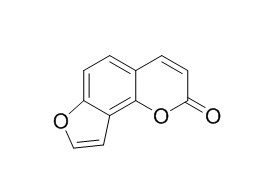Natural Products
Angelicin
| Catalog No. | CFN98854 |  |
| CAS No. | 523-50-2 | |
| Molecular Weight: | 186.2 | |
| Molecular Formula | C11H6O3 | |
| DBs | [PubChem]:274951651 [ChEMBL]:28928 [PCIDB]: |
Standard InChI:
InChI=1S/C11H6O3/c12-10-4-2-7-1-3-9-8(5-6-13-9)11(7)14-10/h1-6H
Biological Activity
Angelicin is a furocoumarin found in Psoralea corylifolia L. fruit, can block the phosphorylation of IκBα, NFκBp65, p38 MAPK, and JNK in lipopolysaccharide-induced acute lung injury model, suggests that angelicin was potentially advantageous to prevent inflammatory diseases by inhibiting NF-κB and MAPK pathways, it might be a potential new agent for prevention of inflammatory reactions and diseases in the clinic.[1]
Angelicin, compared with cytosine arabinoside, mithramycin and cisplatin, is a powerful inducer of erythroid differentiation and -globin mRNA accumulation of human leukemia K562 cells, it is a potential therapeutic approach in hematological disorders, including -beta-thalassemia and sickle cell anemia.[2]
A novel angelicin derivative 6a was identified to inhibit influenza A (H1N1) virus induced Cytopathic effect in Madin-Darby canine kidney cell culture in low micromolar range, these compounds act as anti-influenza agents by inhibiting ribonucleoprotein (RNP) complex associated activity and have the potential to be developed further, which could form the basis for developing additional defense against influenza pandemics.[3]
Angelicin is structurally related to psoralens, a well-known chemical class of photosensitizers used for its antiproliferative activity in treatment of different skin disease, angelicin is an effective apoptosis-inducing natural compound of human SH-SY5Y neuroblastoma cells which suggests that this compound may have a role in future therapies for human neuroblastoma cancer.[4]
Product
References
[1] Liu F, Sun G Q, Gao H Y, et al. J Surg Res, 2013, 185(1):300-9.
[2] Lampronti I, Bianchi N M, Fibach E, et al. Eur J Haematol, 2003, 71(3):189-95.
[3] Yeh J, Coumar M, Horng J, et al. J Med Chem, 2010, 53(4):1519-33.
[4] Rahman M A, Kim N H, Yang H, et al. Mol Cell Biochem, 2012, 369(1-2):95-104.
[5] Yan R, Liu Z, Luo J. Chinese Medicine Modern Distance Education of China, 2008,6(11):1329-30.
Product Use Citation





